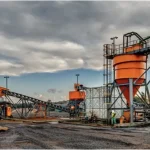In part one of Lubrication from Stone Age to Modern Age (WearCheck Technical Bulletin 88), we slid through 5,000 years of lubrication history and left off at the end of the age of enlightenment in the early 1700s. The next leg of our journey finds us smack bang in the middle of the age of revolution, and a cascading series of events that led to the birth of the modern petroleum industry.
The first industrial revolution (aka The Age of Steam)
1760-1840 CE
Historical context
The ideas that shaped the enlightenment served as catalysts for the late modern period, and ushered in the age of revolution, and revolt: we did! This era witnessed a series of violent political and social transformative revolutions that reshaped the modern world, including the American, French and Haitian revolutions and the Irish Rebellion. It also heralded the First Industrial Revolution.
Honourable mentions from this time period include the theory of atomic structure and evolution, the principle of electromagnetic induction, the further development of the steam engine and telegraph, the invention of the daguerreotype, morse code, smallpox vaccine, bicycle, and spinning jenny.
Guest appearances include Charles Darwin, Michael Faraday, James Joule, John Dalton, Captain James Cook, George Washington, Thomas Muir, Louis Pasteur, and Le Petit Caporal – Napoleon Bonaparte.
The First Industrial Revolution marked a profound shift in the way goods were produced, with a transition from manual labour and small-scale, artisanal production to mechanised and factory-based manufacturing that used large machines which had to run at greater speeds and required more sophisticated lubricants to ensure smooth running.
At this point, we were still very much a horse-and-carriage society reliant on rendered animal fats and vegetable oils for lubrication, but with the quickening pace of progress, the demand for lubricants increased, and we met this need with disastrous consequences.
During this era, sperm whales were extensively hunted for their valuable oil, particularly spermaceti oil, which was highly prized for its use in lubricants and illuminating oils.
Unfortunately, our appetite for progress saw sperm whales almost hunted to extinction. The decline in the whale population skyrocketed the scarcity and expense of the oil, which eventually led to conservation efforts, and also triggered the search for alternative lubricants and lighting fuels towards the end of the First Industrial Revolution.
1845 CE
We see the first use of unrefined petroleum as a lubricant in the new world, in a small cotton-spinning mill in Pittsburgh, Pennsylvania, called Hope Cotton, in 1845.
The owner of the mill combined the crude oil with whale oil to produce a better and cheaper lubricant for his mechanised spindles, and continued to use the concoction secretly for ten years.
Up until the mid-1800s, whale oil was still the primary fuel source for lighting houses and businesses in much of Europe and America, but things were about to change with the invention of kerosene.
1846 CE
Abraham Gesner, a Canadian geologist and physician, is credited with pioneering the commercial production of kerosene from coal tar and shale in 1846. His distillation process allowed for the production of a higher-quality illuminating oil, which burnt more cleanly and was easier to produce and cheaper than whale oil. He also coined the term “kerosene.” Which is derived from the Greek word “keros” (wax) and the Latin word “oleum” (oil).
Gesner, along with several business associates, later went on to create the Kerosene Gas Light Company where Gesner served as the company’s chemist. One of the company’s first major contracts, beginning in 1850, was the lighting of homes and streets in Halifax, Nova Scotia.
As demand for Kerosene grew, the company expanded. Kerosene lamps were now used everywhere to light streets, homes, trains and even ships. Stoves and heaters powered by kerosene became must-have household items.
Gesner’s innovation sparked the rise of the American petroleum industry in the 1850s, and by the end of the decade there were 40 kerosene plants in the United States alone. Unfortunately, he did not obtain his first kerosene patent until 1854 – two years after a Scottish chemist, James Young, obtained his United States patent.
The final blow came in 1859, when oil was discovered in Pennsylvania. Petroleum was a cheaper raw material than the bitumen Gesner had been using, and it lowered the cost of producing kerosene to about one-quarter of its former cost. This should have been good news for Gesner, but instead, he was sacked as the chemist of the company he helped build.
In 1863, he sold his patents to what would eventually become The Standard Oil Company, and returned to Halifax, where he was appointed professor at Dalhousie University. He died the following year, never having made the fortune he deserved.
In honour of his achievements, in 2000 the Canadian government renamed a street in Halifax after him, and put his face on a postage stamp.
1850 CE
Around the same time as Gesner’s work, James “Paraffin” Young, a Scottish chemist, independently developed a process for extracting a similar substance from coal, which he distilled to produce a light, thin oil for use as lamp oil, and a thicker oil suitable for lubricating machinery. He called this product “paraffin oil”. In 1850, he established a paraffin oil works in Bathgate, Scotland, where he produced kerosene, lubricating oils and paraffin wax as byproducts of the refining process.
Apparently unaware of Gesner’s earlier discovery, Young obtained a British patent in 1850 and an American patent in 1852 for his paraffin oil. In the late 1850s, Young sued Gesner’s company for patent infringement and won, so Gesner’s company had to pay royalties to Young to continue manufacturing kerosene.
1851 CE
Back to North America, where we find Samuel M. Kier – an American inventor and entrepreneur – who, like Gesner and Young, also played a significant role in the early development of the oil industry, particularly in the production and commercialisation of kerosene.
Samuel was unsuccessfully making medicine from the unwanted oily byproduct of his father’s salt wells in Pennsylvania, when he wondered if the substance could be used for illumination or lubrication. With the help of a Philadelphia chemist, J.C Booth, Kier developed a practical refining technique that allowed for the separation of crude oil into various components, including kerosene.
In 1851, he marketed his kerosene as “Carbon Oil.” Unfortunately, he never obtained a patent for his developments and many other inventors and businessmen would go on to improve upon his work, yielding huge fortunes. A few years later, Kier went on to establish America’s first oil refinery in Pittsburgh, Pennsylvania and posthumously became known as the grandfather of the American Oil Refinery Industry.
Together, Gesner, Kier, and Young, along with others, played crucial roles in making kerosene a practical and widely used alternative to traditional lighting sources like whale oil during the 19th century. Their contributions were instrumental in the early development of the petroleum industry, and the production of kerosene. On behalf of the whales and humankind, thank you, gentlemen, for lighting our path.
1859 CE
Our timeline continues in Pennsylvania and takes us to a small little town that would become the birthplace of the modern petroleum industry – Titusville, the site of the first American oil well, also known as Drake’s Well.
This story unfolds with an unlikely ensemble of characters – a lawyer, a banker, a university professor, a salt-well driller and a retired train conductor.
George Bissell, a former professor turned New York lawyer, recognised the potential of petroleum as a valuable resource, and believed that petroleum could be used not only for illumination, but also for various industrial applications.
Inspired by Kier’s kerosene operation, Bissell was struck by the ideas that crude oil could be drilled for using the same techniques used to drill salt-water wells.
Bissell got his hands on some Seneca oil from oil seepages in Western Pennsylvania, and hired a chemist from Yale University, Professor Benjamin Silliman, to analyse the properties of the stuff in order to determine its potential as a fuel source and lubricant.
Professor Silliman successfully distilled the Seneca oil into several fractions, proving its usefulness as a high-quality fuel and lubricant. In his report to Bissell, Professor Silliman wrote “your Company have in their possession a raw material from which, by a simple and not expensive process, they may manufacture valuable products”.
Armed with these results, Bissell received financial backing from James Townsend, a wealthy investment banker, to form the Pennsylvania Rock Oil Company in 1854, which later became the Seneca Oil Company under the leadership of Townsend.
However, it wasn’t until 1858 that the Seneca oil company started wildcatting for oil.
While staying at a hotel in Connecticut, Townsend and Bissell became acquainted with one Mr Edwin L Drake, a retired railroad conductor and jack of all trades. Charmed by his demeanour and intellect, Townsend appointed Drake to oversee drilling operations on a piece of land he had purchased in Titusville.
Although referred to as “Colonel”, a title given to him by Townsend to impress the locals in Titusville, Drake was not a military man, nor did he have any experience in drilling wells. His only qualifications were a dash of pioneer blood, a tenacious character and a free railroad pass – the latter being one of the main conditions of his employment.
Drake sought help from people in the area who were experienced salt-well drillers, one of whom was William “Uncle Billy” Smith, the Kier family’s salt-well driller.
Uncle Billy went to work in a pump house that Drake had bought, and built a spring-pole drilling rig – a kind of battering ram which was used to pound metal extraction pipes into the ground. The contraption worked for a while until they hit bedrock. Not deterred, Drake and Uncle Billy installed a 6hp Long John steam engine, at a cost of $500, and stationary boiler, to power the drilling equipment.
This was a significant technological advancement, and demonstrated the use of steam power in drilling, but this device – along with the entire enterprise – was met with scepticism by the town folk, who referred to the venture as Drake’s Folly.
They drilled in vain for months until that fateful day – August the 27th 1859. With the project on the verge of collapse, Drake went to site to check on Uncle Billy, and to his amazement he found the whole drilling team, not drilling, but standing guard at the site with tubs, wash basins and barrels filled with beautiful black oil.
Drake’s perseverance had finally paid off, and he found the vindication he sought at a depth of 21 meters one year after he had embarked on this venture. Despite the significance of his achievement, Drake did not become wealthy from the success of the oil well, and went on to face financial struggles and health issues for the remainder of his life.
Edwin Drake the man responsible for the most important oil strike in history, died penniless in 1880. In 1902, his remains were moved to a cemetery in Titusville, where a memorial statue, “The Driller” by Charles Niehaus, was erected in his honour. In 1934, the Drake Well Museum and Memorial Park were created.
1868 CE
John Ellis was an American doctor and entrepreneur who hung up his stethoscope to pursue his ambition of developing a petroleum-based, high-viscosity lubricant for steam engines. He founded the Continuous Oil Refining Company in Binghamton, USA, and one year later his ambitions were realised when he developed a cylinder oil that met the approval of the prominent steam engine inventor, George Corliss.
Mr Corliss was so impressed with the effectiveness of this lubricant on engine valves that he suggested Ellis name the product Valvoline. So, Ellis did just that. In 1868 he patented the Valvoline process and changed the name of his company to Valvoline. Ellis would go down in history as the man who formulated the world’s first petroleum-based motor oil. More than 50 years later Valvoline would go on to be the only oil recommended by the Ford Motor Company in its Model T Fords.
Second Industrial Revolution (aka the Age of Electricity, or the Gilded Age)
1870-1914 CE
Historical context
As the years rolled by, the First Industrial Revolution morphed into the Second Industrial Revolution, bringing with it even greater advances in technology, the widespread use of electricity and a blossoming love affair with all things petroleum.
Honourable mentions from this time period include the invention of the light bulb, the telephone, radio, the Kodak camera, the alternating current (AC) electrical system and the Benz Patent-Motorwagen.
Guest appearances by Thomas Edison, Nikola Tesla, Alexander Graham Bell, Rudolph Diesel, Gottlieb Daimler, Wilhelm Maybach, Karl Benz, Marie Curie, Albert Einstein and our favourite fly boys – the Wright brothers.
1870 CE
The nation’s oil bonanza in America had begun, and huge fortunes would soon be made, however, it would not be a straight-upwards trajectory. The rapid growth in production led to an oil glut, and the price quickly dropped, driving many producers out of business. The petroleum industry was experiencing its first boom and bust cycle. It continued to spike and drop in the first volatile decade after its discovery, until a shrewd visionary businessman came on the scene and revolutionised the oil industry. His name was John D Rockefeller, otherwise known as “Chowder”.
Often regarded as one of the most influential figures in the history of the petroleum industry, Rockefeller brought order to the industry by monopolising it. He took his first major step in 1865, when he acquired full ownership of a major refinery in Cleveland, Ohio. By 1870 Rockefeller controlled several refineries in Cleveland, and in the same year, he founded the Standard Oil Company, which was later referred to as “The Club”, by staff.
Rockefeller continued to grow Standard through a number of different ways; some more dubious than others. He was incredibly innovative and found ways to increase productivity and efficiencies through economies of scale and vertical integration.
By 1878 — after just eight years — Standard Oil had grown from controlling 4% to 95% of the entire oil business in the United States, and held significant interests in much of the rest of the world.
Over the subsequent decades, the size and market share of Standard Oil began to draw the ire of the American public and legislature, and finally in 1911, due to a ruling by the US Supreme Court, Standard Oil was split into 34 smaller companies. The smaller companies that emerged from the breakup would later go on to form the major multinational oil corporations we are familiar with today, like Mobil, Exxon and Chevron.
Love him or hate him, John D Rockefeller was the poster boy of the oil industry during this age, and this captain of industry left an indelible mark.
1872 CE
Ever wondered where the idiom “The real McCoy” comes from?
It started with a Canadian-born American inventor and engineer, Elijah McCoy. McCoy invented an automatic lubricator that was used to apply oil through a drip cup to locomotive and ship steam engines. His invention allowed machinery to run more smoothly and efficiently, reducing the need for frequent manual lubrication and downtime. The automatic lubrication system was particularly crucial in industries like railroads and manufacturing, where equipment required constant lubrication to function properly.
McCoy’s invention was so reliable and effective, that railroad engineers insisted on McCoy lubrication systems when buying new machines, and would take nothing less than what became known as “the real McCoy”. A phrase that is now synonymous with something genuine and of high quality.
1877 CE
French chemist Charles Friedel and his American collaborator, James Mason Crafts, developed the first synthetic hydrocarbon oil in 1877. Their work involved the reaction of olefins (unsaturated hydrocarbons) with hydrogen chloride in the presence of a catalyst – aluminium trichloride. This process, known as the Friedel-Crafts reaction, allowed for the synthesis of hydrocarbons with properties similar to those of natural mineral oils.
While the synthetic oil they produced at that time had limited applications, this milestone laid the foundation for further advancements in the field of synthetic chemistry and the eventual development of synthetic lubricants and fuels.
For their efforts, Charles and James were made chevaliers (knights) of the Legion of Honor by the French government in 1885.
1886 CE
Professor Osborne Reynolds was a prominent Irish-born engineer and physicist known for his significant contributions to the fields of fluid dynamics and engineering.
He is best known for introducing the concept of the “Reynolds number,” a dimensionless quantity that characterises the flow of fluids, specifically the transition between laminar and turbulent flow. It has become a fundamental parameter in fluid mechanics and is used to predict the behaviour of fluid flow in various engineering applications like lubricants within mechanical systems.
In 1886, the good professor also published a remarkably insightful paper, with a really long title, that gave birth to the theory of lubrication – “On the Theory of Lubrication and its Application to Mr. Beauchamp Tower’s Experiments, including an Experimental Determination of the Viscosity of Olive Oil”.
In this paper, he formulated the Reynolds equation, which is a central component of lubrication theory, and describes how pressure, viscous forces, and relative velocity affect the lubrication of the contact surfaces. This paper is considered a seminal work in the field of lubrication, and laid the foundation for the theory of hydrodynamic lubrication.
1902 CE
Richard Stribeck was a German engineer and university professor, who conducted extensive experiments in the early 20th century to study the frictional behaviour of lubricated sliding surfaces like journal bearings.
He observed that the friction coefficient in the mechanical systems that he studied exhibited a characteristic curve with distinct regions, and this observation led to the development of one of the most famous and widely recognised curves in the field of tribology – the Stribeck curve.
The Stribeck curve is a fundamental tribological concept that graphically represents the transition from boundary lubrication to mixed lubrication and finally to hydrodynamic lubrication, as the lubricant film thickness and speed change. This curve proved to be a valuable tool for selecting the appropriate lubricant, designing bearings and lubrication systems and improving the overall performance of lubricated machinery.
1905 CE
In the early 1900s, there were dozens of automobile manufacturers in the United States, and many more worldwide. Many of these manufacturers expressed a desire to have a platform that would encourage free exchange of ideas to solve common technical design issues in the rapidly developing field of automotive engineering.
Enter Peter Heldt and Horace Swetland, two prominent automotive magazine publishers, who recognised the need for a collaborative organisation, and advocated for the creation of a technical forum of automotive manufacturers and engineers, who would share knowledge and collectively develop industry standards.
In March of 1905 in New York City, the Society of Automobile Engineers, or SAE, was founded by a group of industry professionals, with Henry Ford serving as the society’s first vice president
The SAE would go on to change its name to the Society of Automotive Engineers in 1916 and again to SAE International in 1986, to reflect the organisation’s global reach, and its commitment to advancing engineering and technical standards across various industries.
1907 CE
Would it surprise you to know that one of the largest and most prominent multinational energy companies in the world traces its routes to a small antique shop in London?
It all started with Marcus Samuel Sr, an antique dealer who, in 1833, decided to capitalise on the popularity of oriental seashells in the interior design industry. The demand was so great that he began importing the shells from the Far East, laying the foundations for an import-export business that would one day become one of the world’s leading energy companies.
When Marcus Samuel senior died in 1870, he passed the business on to his two sons, Marcus junior and Samuel, who began to expand it. In the 1880s, they became particularly interested in the oil-exporting business, but the key problem in the oil-trade business at the time was shipping. Oil was carried in barrels, which took up a substantial amount of space on ships, and also ran the risk of leaking.
To solve the problem, they commissioned a fleet of steamers to carry oil in bulk, including the SS Murex (named after a genus of tropical sea snail) which, in 1892, became the first bulk oil tanker to pass through the Suez Canal.
Interesting fact for maritime enthusiasts: the Murex was requisitioned by the Admiralty to assist the allies during WWI, but was sunk after being torpedoed by an Imperial German Navy submarine in 1916. For her contribution to the war effort, she was given the battle honour “Rabaul 1914”.
But fear not, the Murex was reincarnated in 2017. To mark 125 years of shipping heritage, Shell named one if its Liquefied Natural Gas (LNG) carriers the Murex in honour of its first oil tanker. Don’t you just love happy endings!
Back to the story – the brothers’ main competitor at the time was Standard Oil, whose blue kerosene cans had a strong brand identity in the market. To stand out, they painted their cans bright red with a simple mussel shell design – and so began the iconic brand.
The tactic worked and, by 1896, their kerosene trade was earning more than all their other businesses combined, so, in 1897, Marcus and Samuel renamed their company the Shell Transport and Trading Company.
However, by 1902, overproduction in the United States had slashed the available supply to virtually nothing. At the same time, a smaller competitor called Royal Dutch had begun to construct its own tankers and set up its own organisation in Asia.
As a result, half of Shell’s fleet sat idle. So, in 1907, the decision was taken to merge Shell Transport and Trading Company with Royal Dutch and form the Royal Dutch Shell Group or just Shell for short. The day the telegram was received announcing the merger, April 23rd 1907, is now celebrated every year as Shell’s birthday.
From shipping shells to oil wells, the Shell brand has grown to become one of the most well recognised in the world.
Be sure to catch the final instalment of our timeline in Technical Bulletin 90, where we will delve into how a burgeoning auto industry and two world wars shaped lubricant formulation, how Teflon was accidently discovered, and the origins of the term “tribology”. We will take to the skies with synthetic oils and recount how a bun fight between two oil companies redefined how we classify oils.
For further information, visit www.wearcheck.co.za, email marketing@wearcheck.co.za or call WearCheck’s head office on +27 (31) 700-5460.
ENDS [3,750 words]
E: marketing@wearcheck.co.za W: www.wearcheck.co.za T: +27 (31) 700-5460
About the author: Steven Lara-Lee Lumley is in charge of technical development and training for WearCheck. She holds an N6 mechanical engineering diploma (HND N6) as well as Honeywell aerospace and ICML III accreditations.
Steven joined WearCheck in 2008 as a diagnostician and worked her way up to the position of senior diagnostician, during which time she diagnosed her millionth used oil sample, in addition to running oil analysis training courses for customers in several countries. In 2015, Steven was promoted to the position of technical manager.
Caption:
WearCheck’s technical manager, Steven Lumley.
Released on behalf of WearCheck by Just Write Public Relations
Media queries: Sharon 082 8230539 or sharon@justwritepr.co.za















